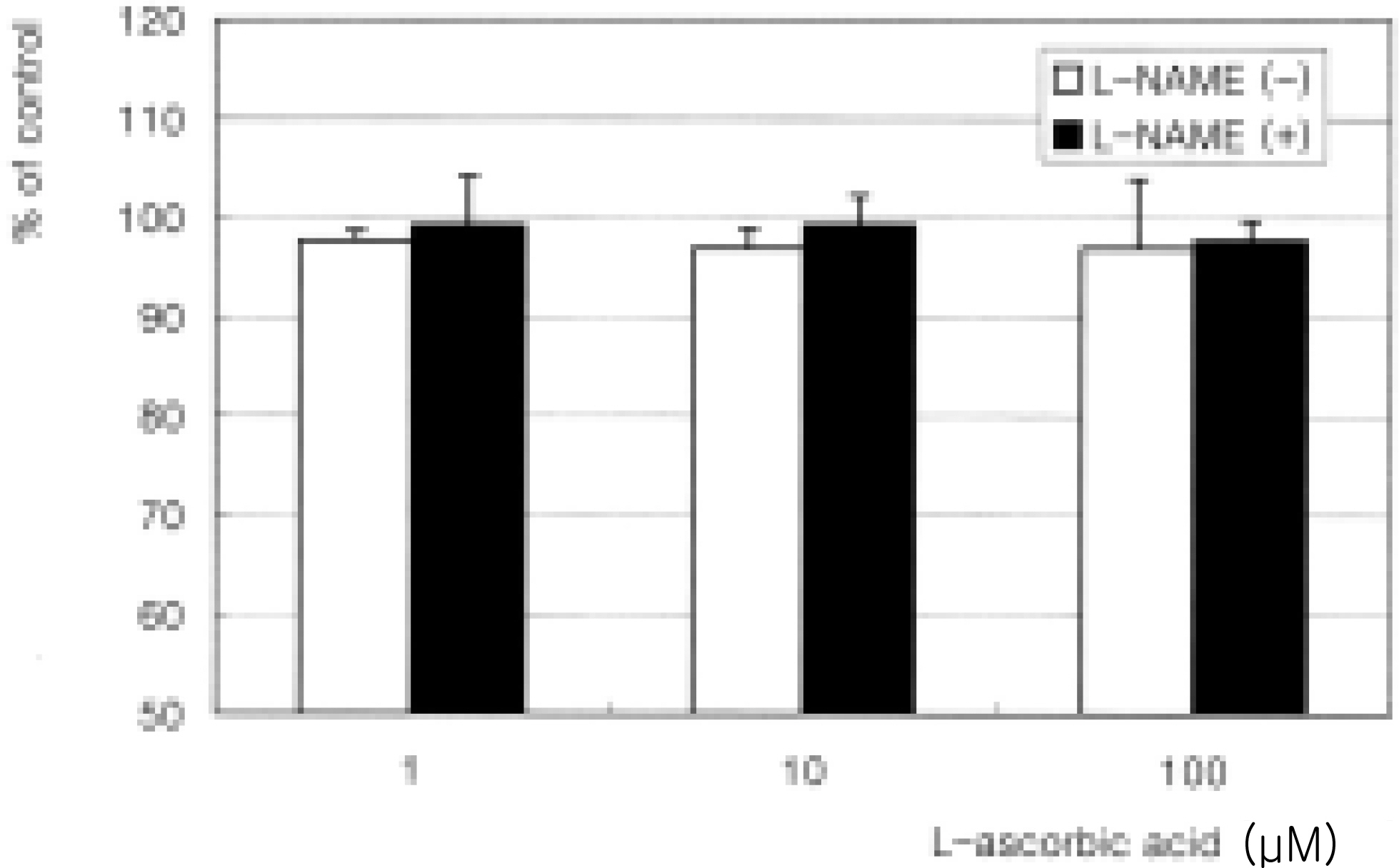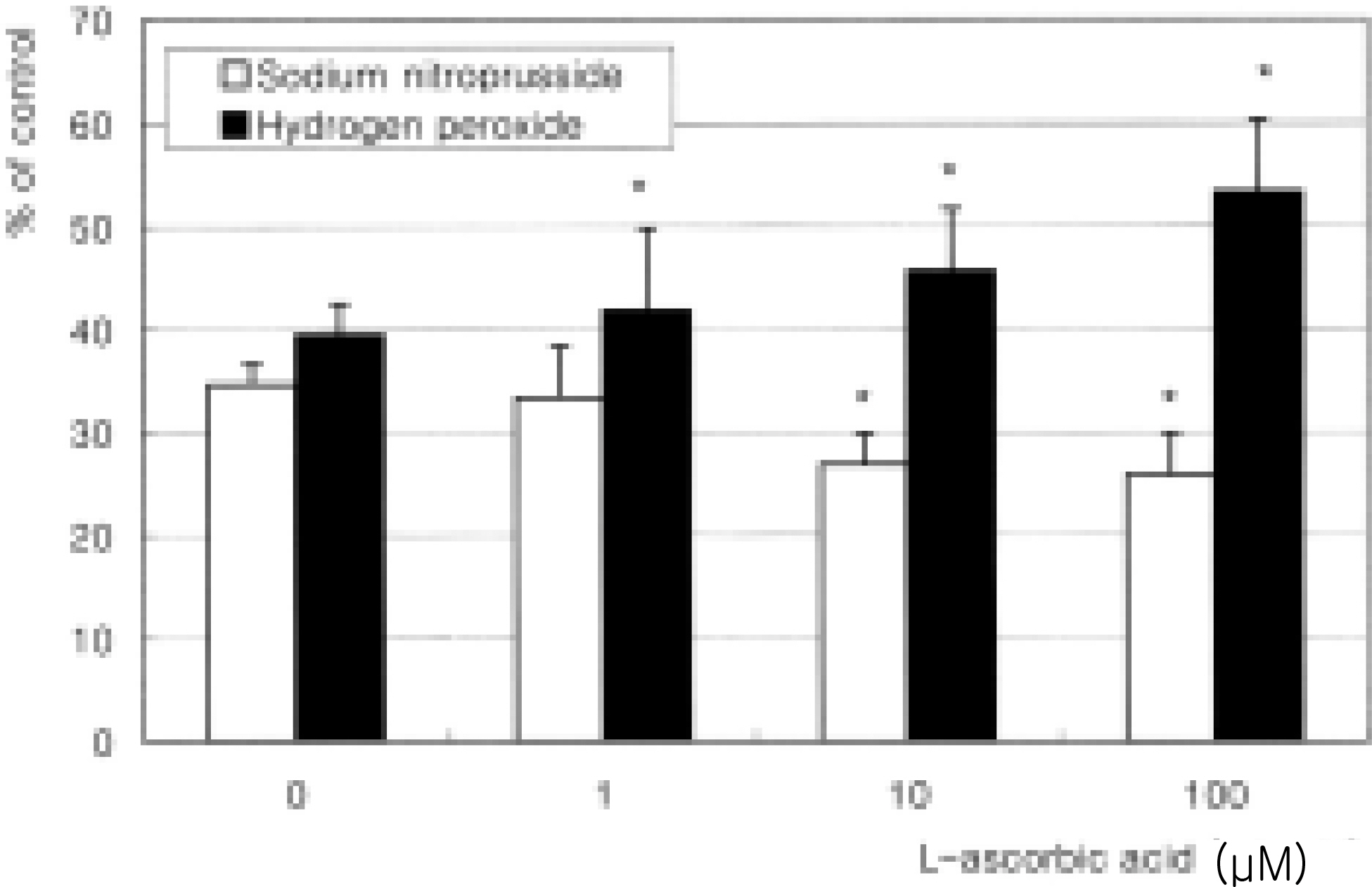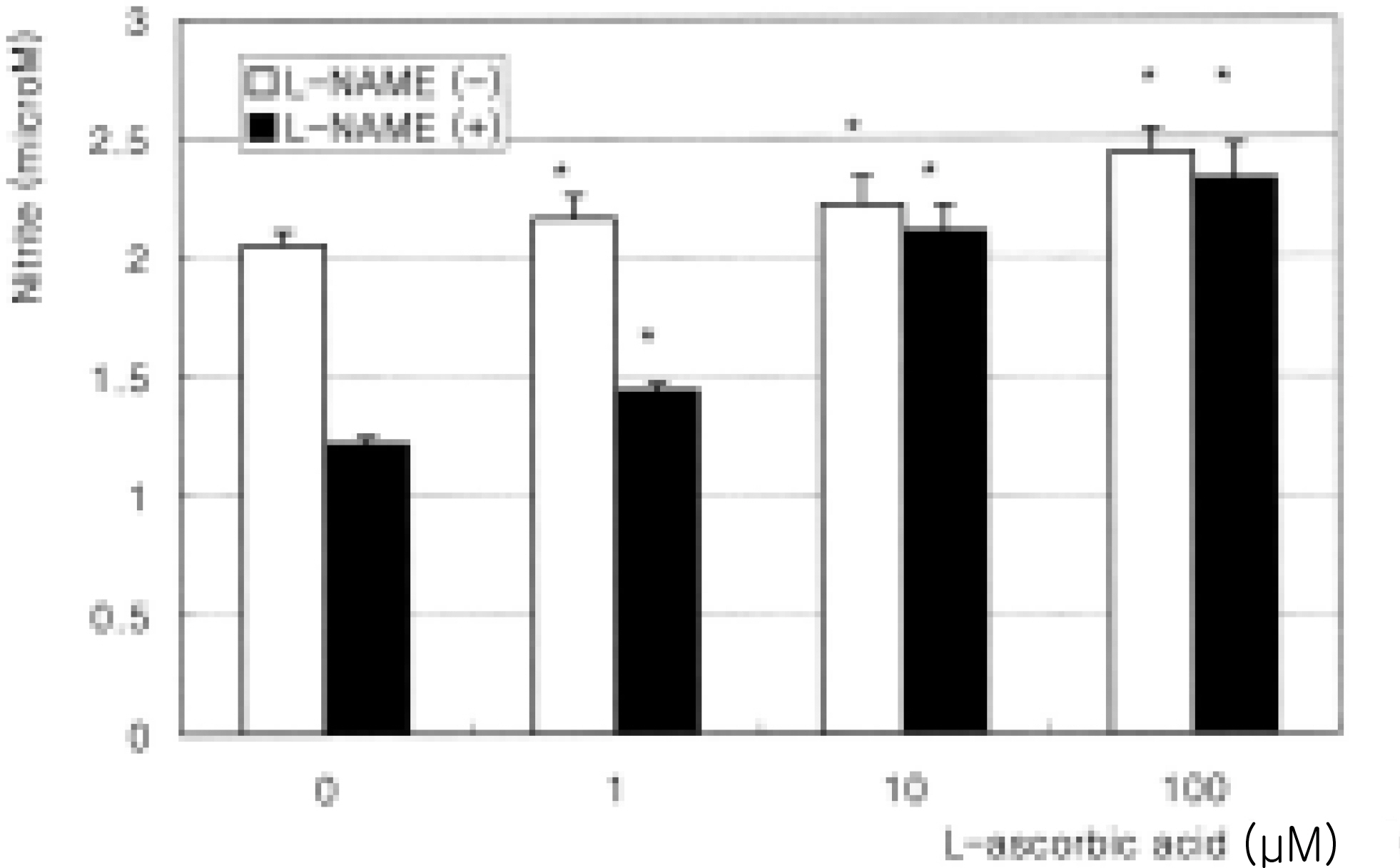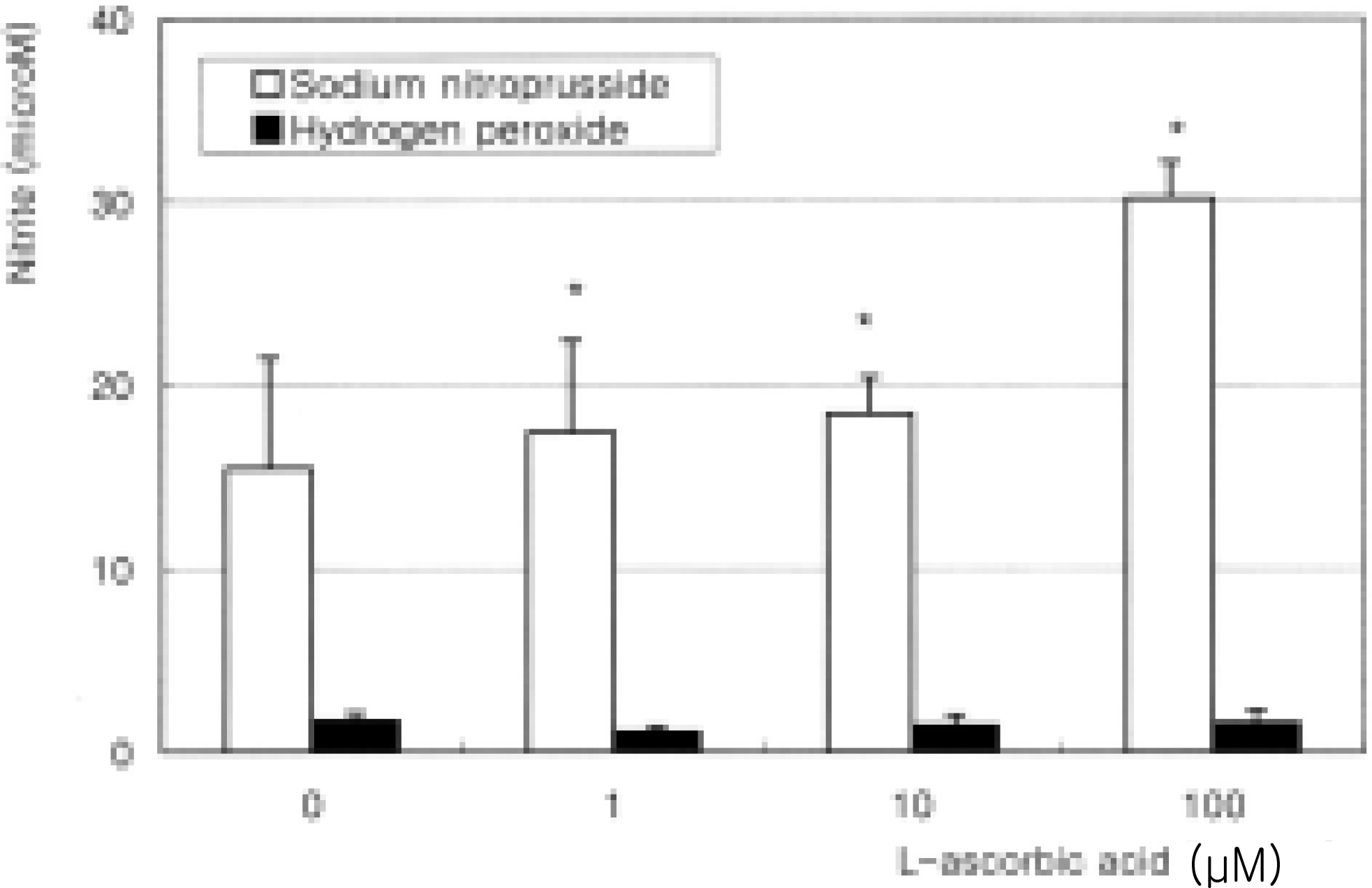Korean J Ophthalmol.
2005 Sep;19(3):227-232. 10.3341/kjo.2005.19.3.227.
Ascorbic Acid Enhances Nitric Oxide Production in Trabecular Meshwork Cells
- Affiliations
-
- 1Department of Ophthalmology, Catholic University of Daegu College of Medicine, Daegu, Korea. jwkim@cu.ac.kr
- KMID: 754429
- DOI: http://doi.org/10.3341/kjo.2005.19.3.227
Abstract
- PURPOSE
This study investigated the role of ascorbic acid on the production of nitric oxide (NO) in the trabecular meshwork (TM) cells. METHODS: After primarily cultured human TM cells were exposed to 1, 10, and 100 micrometer of L-ascorbic acid (LAA), with or without co-administration of 1 mM sodium nitroprusside or 100 micrometer hydrogen peroxide for 48 hr, cellular survival and NO production were measured with MTT and Griess assay, respectively. RESULTS: LAA significantly potentiated NO production in a dose-dependent manner (p< 0.05) without affecting cell viability. LAA increased cell viability after hydrogen peroxide-induced oxidative stress in a dose-dependent manner. LAA enhanced NO production in TM cells and showed a cytoprotective effect against hydrogen peroxide-induced oxidative stress. CONCLUSIONS: LAA might be involved in the regulation of trabecular outflow by enhancing NO production in TM cells.
MeSH Terms
Figure
Cited by 1 articles
-
Effect of Ascorbic Acid Against the Oxidative Stress-Induced Cellular Senescence in Trabecular Meshwork Cells
Jae Woo Kim, Sun Hee Kang, Keun Woo Lee
J Korean Ophthalmol Soc. 2013;54(3):490-495. doi: 10.3341/jkos.2013.54.3.490.
Reference
-
1. Moncada S, Palmer RMJ, Higgs EA. Nitric oxide: physiology, pathophysiology, and pharmacology. Pharmacol Rev. 1991; 43:109–42.2. Bredt DS, Snyder SH. Nitric oxide: a physiologic messenger molecule. Annu Rev Biochem. 1994; 63:175–95.
Article3. Becquet F, Courtois Y, Goureau O. Nitric oxide in the eye: multifaceted roles and diverse outcomes. Surv Ophthalmol. 1997; 42:71–82.
Article4. Nathanson JA, McKee M. Identification of an extensive system of nitric oxide-producing cells in the ciliary muscle and outflow pathway. Invest Ophthalmol Vis Sci. 1995; 36:1765–73.5. Geyer O, Podos SM, Mittag T. Nitric oxide synthase activity in tissues of the bovine eyes. Graefe Arch Clin Exp Ophthalmol. 1997; 235:786–93.6. Meyer P, Champion C, Schlotzer-Schrehardt U, et al. Localization of nitric oxide synthase isoforms in porcine ocular tissues. Curr Eye Res. 1999; 18:375–80.
Article7. Schuman JS, Erickson K, Nathanson JA. Nitrovasodilator effects on intraocular pressure and ocular facility in monkeys. Exp Eye Res. 1994; 58:99–105.8. Wana RF, Podos SM. Effect of the topical application of nitroglycerin on intraocular pressure in normal and glaucomatous monkeys. Exp Eye Res. 1995; 60:337–9.9. Nathanson JA, McKee M. Alteration of ocular nitric oxide synthase in human glaucoma. Invest Ophthalmol Vis Sci. 1995; 36:1774–84.10. Matsuo T. Basic nitric oxide production is enhanced by hydraulic pressure in cultured human trabecular cells. Br J Ophthalmol. 2000; 84:631–5.11. Becker B. Chemical composition of human aqueous humor. Effects of acetazolamide. Arch Ophthalmol. 1957; 57:793–800.12. Erb C, Nau-Staudt K, Flammer J, Nau W. Ascorbic acid as a free radical scavenger in porcine and bovine aqueous humour. Ophthalmic Res. 2004; 36:38–42.
Article13. Heller R, Munscher-Pailug F, Grabner R, Till U. L-ascorbic acid potentiates nitric oxide synthesis in endothelial cells. J Biol Chem. 1999; 274:8254–60.
Article14. May JM. How does ascorbic acid prevent endothelial dysfunction? Free Radic Biol Med. 2000; 28:1421–9.
Article15. Ross R. Atherosclerosis-an inflammatory disease. N Eng J Med. 1999; 340:115–26.16. Blosi MS. Antioxidant determinations by the use of a stable free radical. Nature. 1958; 181:1199–200.
Article17. Polansky JR, Weinreb RN, Baxter JD, Alvarado J. Human trabecular cells. I. Establishment in tissue culture and growth characteristics. Invest Ophthalmol Vis Sci. 1979; 18:1043–9.18. Polansky JR, Wood IS, Maglio MT, Alvarado JA. Trabecular meshwork cell culture in glaucoma research: Evaluation of biological activity and structural properties of human trabecular meshwork cells in vitro. Ophthalmology. 1984; 91:580–95.19. Kahler CM, Heroid M, Reinisch N, Wiedermann CJ. Interaction of substance P with epidermal growth factor and fibroblast growth factor in cyclooxygenase-dependent proliferation of human skin fibroblasts. J Cell Physiol. 1996; 166:601–8.20. Gomm JJ, Coope RC, Browne PJ, Coombes RC. Separated human breast epithelial and myoepithelial cells have different growth factor requirements in vitro but can reconstitute normal breast lobuloalveolar structure. J Cell Physiol. 1997; 171:11–9.
Article21. Green LC, Wagner DA, Glogowski J, et al. Analysis of Nitrate, Nitrite and [15N]Nitrate in biologic fluids. Analytical Biochem. 1982; 126:131–8.22. Harris IJ. Chemical test for vitamin C, and the reducing substances present in tumor and other tissues. Nature. 1933; 132:27–8.23. Heath H. The distribution and possible function of ascorbic acid in the eye. Exp Eye Res. 1962; 1:362–7.24. Reiss GR. Ascorbic acid levels in the aqueous humor of nocturnal and diurnal mammals. Arch Ophthalmol. 1986; 104:753–5.
Article25. Reddy VN, Giblin FJ, Lin L-R, Chakrapani B. The effect of aqueous humor ascorbate on ultraviolet-B-induced DNA damage in lens epithelium. Invest Ophthalmol Vis Sci. 1998; 39:344–50.26. Huang A, Vita JA, Venema RC, Keaney Jr JF. Ascorbic acid enhances endothelial nitric-oxide synthase activity by increasing intracellular tetrahydrobiopterin. J Biol Chem. 2000; 275:17399–496.
Article27. Heller R, Unbehaun A, Schnellenberg B, et al. L-ascorbic acid potentiates endothelial nitric oxide synthesis via a chemical stabilization of tetrahydrobiopterin. J Biol Chem. 2001; 276:40–7.
Article28. Higginbotham EJ, Yue BYJT, Crean E, Peace J. Effects of ascorbic acid on trabecular meshwork cells in culture. Exp Eye Res. 1988; 46:507–16.
Article29. Yue BYJT, Higginbotham EJ, Chang IL. Ascorbic acid modulates the production of fibronectin and laminin by cells from an eye tissue-trabecular meshwork. Exp Cell Res. 1990; 187:65–8.
Article30. Sawaguchi S, Yue BYJT, Chang IL, et al. Ascorbic acid modulates collagen type I gene expression by cells from an eye tissue-trabecular meshwork. Cell Mol Biol. 1992; 38:587–604.31. Chiou GCY. Review: effects of nitric oxide on eye disease and their treatment. J Ocul Pharmacol Ther. 2001; 17:189–98.32. Lee PF, Lam KW, Lai MM. Aqueous humor ascorbate concentration and open angle glaucoma. Arch Ophthalmol. 1977; 95:308–10.33. Fong D, Etzel K, Lee PF, et al. Factors affecting ascorbate oxidation in aqueous humor. Curr Eye Res. 1987; 6:357–61.
Article34. Becker B. Topical 8-bromo-cyclic GMP lowers intraocular pressure. Invest Ophthalmol Vis Sci. 1990; 31:1647–9.35. Nathanson JA. Nitrovasodilators as a new class of ocular hypotensive agents. J Pharmacol Exp Ther. 1991; 260:956–65.36. Wiederholt M, Sturm A, Lepple-Wienhues A. Relaxation of trabecular meshwork and ciliary muscle by release of nitric oxide. Invest Ophthalmol Vis Sci. 1994; 35:2515–20.37. Francine FB-C. Oliver G, Francois D'H, Yves C. Decreased intraocular pressure induced by nitric oxide donors is correlated to nitrite production in the rabbit eye. Invest Ophthalmol Vis Sci. 1996; 37:1711–5.38. Kojima S, Sugiyama T, Shimizu K, et al. Effect of a nitric oxide donor on intraocular pressure. J Jpn Ophthalmol Soc. 1996; 100:181–6.39. Millar J. The nitric oxide/ascorbate cycle: how neurons may control their own oxygen supply. Med Hypotheses. 1995; 45:21–6.40. Ignarro LJ, Fukuto JM, Griscavage JM, et al. Oxidation of nitric oxide in aqueous solution to nitrite but not nitrate: comparison with enzymatically formed nitric oxide from L-arginine. Proc Natl Acad Sci USA. 1993; 90:8103–7.
Article41. Linner E. The effect of ascorbic acid on intraocular pressure. Paterson G, Miller SJH, Paterson GD, editors. Drug mechanisms in glaucoma. London: J & A Churchill;2006. p. 153–64.42. Jampel HD, Moon JI, Quigley HA, et al. Aqueous humor uric acid and ascorbic acid concentrations and outcome of trabeculectomy. Arch Ophthalmol. 1998; 116:281–5.
Article43. Kang JH, Pasquale LR, Willett W, et al. Antioxidant intake and primary open-angle glaucoma: A prospective study. Am J Epidemiol. 2003; 158:337–46.
Article44. Lipton SA, Choi YB, Sucher NJ, Chen HS. Neuroprotective versus neurodestructive effects of NO-related species. Biofactors. 1998; 8:33–40.
Article45. Kim YM, Bombeck CA, Billiar TR. Nitric oxide as a bifunctional regulator of apoptosis. Circ Res. 1999; 84:253–6.
Article46. Jampel HD. Ascorbic acid is cytotoxic to dividing human Tenon's capsule fibroblasts: A possible contributing factor in glaucoma filtration surgery success. Arch Ophthalmol. 1990; 108:1323–5.47. Denk PO, Knorr M. In vitro effect of ascorbic acid on the proliferation of bovine scleral and Tenon's capsule fibroblasts. Eur J Ophthalmol. 1998; 8:37–41.
Article48. Bohmer JA, Sellhaus B, Schrage NF. Effects of ascorbic acid on retinal pigment epithelial cells. Curr Eye Res. 2001; 23:206–14.49. Pirie A. A light-catalyzed reaction in the aqueous humor of the eye. Nature. 1965; 205:500–1.50. Tamm ER, Russell P, Johnson DH, Piatigorsky J. Human and monkey trabecular meshwork accumulate (B-crystalline in response to heat shock and oxidative stress. Invest Ophthalmol Vis Sci. 1996; 37:2402–13.
- Full Text Links
- Actions
-
Cited
- CITED
-
- Close
- Share
- Similar articles
-
- Effect of Dexamethasone on the Production of Nitric Oxide in Trabecular Meshwork Cells
- Role of Ascorbic Acid Against the Oxidative Stress in Trabecular Meshwork Cells
- Effect of Mitomycin C on the Proliferation and Nitric Oxide Production in the Cultured Trabecular Meshwork Cells
- Effect of Ascorbic Acid Against the Oxidative Stress-Induced Cellular Senescence in Trabecular Meshwork Cells
- Insulin Enhances Nitric Oxide Production in Trabecular Meshwork Cells via De Novo Pathway for Tetrahydrobiopterin Synthesis





